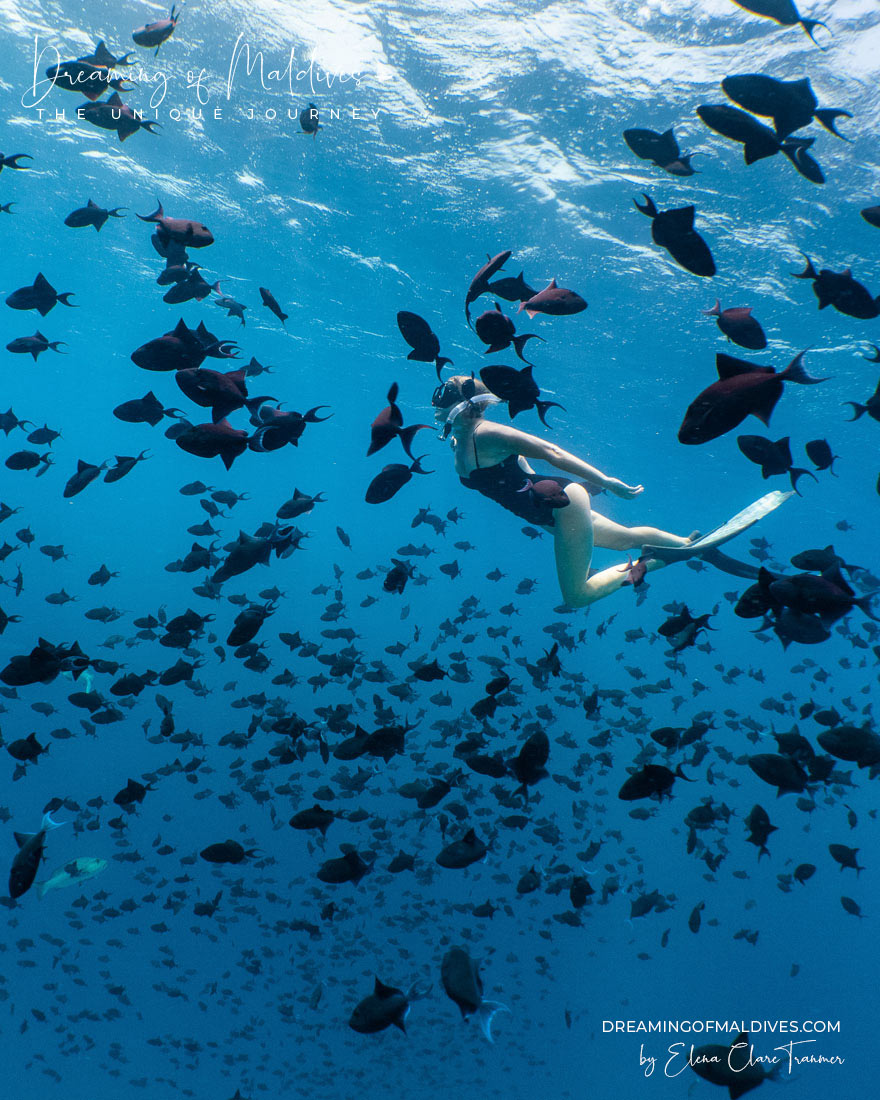Discover the secrets and peculiarities of 10 of the most common fishes in the Maldives in this illustrated snorkeling guide. Learn to identify them and delve into their little secrets and fun rituals!

Have you ever wondered about the variety of fishes you can meet while snorkeling in the Maldives?
There are more than 2000 fish species in their waters, so, needless to say that your chances to meet them are very high !
Dreaming of Maldives channel : Subscribe to our Channel for more videos !
In Maldives, snorkeling is a MUST-DO !
There, right in front of your mask, you will meet countless tropical fishes with pretty names and colors : the Moorish Idol, quintessence of the reef fish, schools of Oriental sweetlips, with their plump lips, the noisy coral-nibbling Parrotfish, the small clownfish hidden in its anemone like Nemo, the strange looking and ferocious Trumpetfish, or the Picasso Triggerfish, living work of art,…the list goes on and on…
It’s magic !
But the real magic happens when you know more about their little secrets and rituals.
Maldives waters are an endless playground swirling with fishes and colors.
The 10 fishes that you will surely meet while snorkeling in Maldives
Put on your snorkeling gear and follow me to discover more about 10 of your future underwater companions !
While snorkeling, take a moment to observe them, they are just as beautiful as they are fun to watch !
- The Parrotfish
- The Moorish Idol
- The Trumpetfish
- The Powder Blue Surgeonfish
- The Clownfish
- The Convict Surgeonfish
- The Threadfin Butterflyfish
- The Blacktip Reef shark
- The Picasso Triggerfish
- The Oriental Sweetlips
Marine Ecosystems are
extremely fragile.
Before you go living the underwater Dream, here are
The 3 basic rules of a well-behaved snorkeler
Please
- DO NOT touch anything.
Coral included ! - DO NOT step on Corals.
- DO NOT litter.
The Parrotfish


Snorkeling
At W Maldives
review
W Maldives is a snorkeling paradise. The superb luxury resort has a breathtaking close-by reefs where thousands of fishes, turtles and corals are waiting for you at a step away from your villa.
The Parrotfish is my favorite in this list. They are the funniest encounter of my snorkeling explorations. They are not only super colorful ( their colors remind of parrots from which they took their names ), they also make an unmistakable noise !
Parrotfishes have a strong beak which is also similar to parrots and spend a lot of time nibbling algae from corals and rocks.
There is something more about the parrotfish : they poop back the corals and stones that are not digested into sand.
Their poop composes a large quantity of the beautiful Maldives sand.
One Parrotfish eats enough coral in one year to produce a ton of sand.
Yes, the fine sand that you love in the Maldives is partly poop. It is said that they eat so much corals that a single individual can produce a ton of sand per year.
Take some time to observe them.
Their little business is a guaranteed educational show with audio !
Parrotfish were added to the list of marine protected species in the Maldives in 2020.
Scientific name : Scaridae
The Moorish Idol

You will surely see the magnificent moorish idol in the Maldives and this, from your first dives, even in shallow waters.
Often solitary (or in small groups of 3/4 individuals, but this is rarer), the moorish idol generally evolves in 2 or 3 meters depth but you might also spot it in deeper waters, on the island drop-off.
Considered as one of the most beautiful tropical fish, the elegant moorish idol can reach up to 25 cm in length and is easily spotted.
Moorish Idols are often confused with the Schooling Bannerfish and the longfin bannerfish, also called the Pennant Coralfish.
The moorish idol is often confused with the schooling bannerfish or its cousin the pennant coralfish. It is true that to the untrained eye and without precise details, they can be confused one for another.
Hereunder are schooling bannerfish :

Pretty similar, right ?
In order to know if you are meeting the iconic reef fish that the moorish idol is, or a fish from the Butterfly family, which are also beautiful, but not as much :-), there are several differences to remember.
If you are interested in playing this little Spot the Difference game, you will find it here.
One last thing : Gill, in the movie Finding Nemo is a Moorish Idol.
Scientific name : Zanclus cornutus
The trumpetfish

The trumpetfish or flutemouth is a long, elongated fish with a stretched body and jaw, which remind of a flute or a trumpet.
But don’t be fooled, underneath its elegant appearance lies a fearsome predator that loves to suck up and eat small fish.
The Trumpetfish is one of the most voracious predators of the reef and a king of camouflage.
Their long mouth is a fast, powerful and precise weapon with strong sucking power. They are king hunters and can change color to blend in, hide in the grass to spy on their prey until they suck in their fooled victim, in a split second.
Master of camouflage, the trumpetfish sometimes hide itself by swimming closely behind another bigger fish while hunting or…being hunted.
They generally live alone and are active during the day.
In Maldives you will see trumpetfish in various colors ranging from beige to red, blue or yellow, as in the photo above, which is a Chinese Trumpetfish.
The trumpetfish is often confused with its cousin the cornetfish which looks very similar but is thinner and does not have the same tail.
Scientific name : Aulostomidae.
The Powder blue surgeonfish


interview
Snorkeling
& Diving
At Reethi Beach
Reethi Beach Resort is one of the most fabulous Maldives resort for snorkeling and diving.
In the Maldives, as in all tropical seas, you will often see powder blue surgeonfish on the reefs. They can be found alone but are mostly spotted schooling around corals on which they eat algae. They have tiny sharp teeth (too small for us to be seen underwater) and are peaceful to divers.
The Surgeonfish have two sharp parts at the ends of their tails called scalpel.
Like all surgeonfish – there are about 75 in the family – they can be vindictive with other fishes for territorial reasons or if they feel in danger. In aggressive mode, they tend to attack with their mouth and can injure their enemy with their tail, which has a sharp part called a “scalpel” on each end.
Their colors range from light to dark blue on the body, with yellow on their dorsal fin.
The powder blue surgeonfish is not Dory from Finding Nemo. The adorable amnesiac blue lady is a blue tang fish.
Scientific name : Acanthurus leucosternon.
The Clownfish

There are about thirty different species of clownfish around the world.
In Maldives, on the picture above, you will see one of the most common one, the amphiprion nigripes, endemic to the archipelago.
The clownfish is also called anemonefish because of its total symbiosis with it.
The clownfish is one of the only fishes known to live in the venomous tentacles of anemones.
The anemone provides them with a home and a protection as well as food. In return, the clownfish defends the anemone from predators and parasites. It is one of the only fish known to be able to live in these venomous tentacles thanks to a mucus that protects its body.
The Amphiprion Nigripes is a close cousin of Nemo, the adorable star of Pixar, which is the most common clownfish, called Amphiprion ocellaris.
Scientific name : Amphiprion nigripes.
The Convict surgeonfish

The beautiful convict surgeonfish is also part of the large family of the surgeonfish.
Reminding of a prisoner with its vertical black stripes on its body, the convict surgeonfish is a schooling specie daily spotted in shallow lagoons.
In the Maldives, as long as you chose to stay on a good island for snorkeling ( Type 1 or 3 ), you will very often see them from your first steps in the lagoon. They are not very shy and can be easily approached.
The Convict Surgeonfish is one of the most common fish in the Maldives.
Similar to other surgeonfish, they spend their time grazing on algae that develop on corals and boast the famous ‘scalpel’ on their tail, just like the powder blue surgeonfish, who also makes an appearance in this list, at number 4.
Scientific name: Acanthurus triostegus
The Threadfin butterflyfish


review
Snorkeling
At Baros Maldives
Baros Maldives is known to be one of the Maldives best resort for snorkeling. The small Luxury island is surrounded by a superb house reef at its proximity.
The threadfin butterflyfish is another one of my favorites in this list. It not only has a pretty name but also a very graphic coat pattern.
White, but yellow at the back, it has a large black spot on the soft part of its dorsal fin and a prominent black stripe across the eye.
Its beauty especially lies in the 2 series of oblique gray lines that cross its body and meet at right angles, in a perfect and harmonious symmetry to form chevrons.
The Threadfin Butterflyfish often lives in couple and keeps the same partner during its whole life.
In Maldives, you will often see these graceful creatures, alone -for the younger ones or in pairs -as adults, in shallow lagoons. They are known to keep the same partner during their lifetime.
Scientific name: Chaetodon auriga.
The Blacktip Reef Shark


interview
Snorkeling
& Diving
At Amilla Maldives Resort & Residences
Discover one of the most extraordinary Resort to dive and snorkel in style in Maldives !
The blacktip reef shark is the most common shark in the Maldives. You may have already seen a video of sharks alone or in small pack swimming along the beach. Although impressive for a novice eye, these scenes are often narrated with exaggeration to generate some kind of “buzz”.
They are not dangerous nor a risk for any human. These sharks are simply juveniles learning to hunt on their own, their mother being totally devoid of maternal instinct.
Blacktip Reef Sharks are abundant in the Maldives. Juveniles learn to hunt on the beach, once adults, they will stay around the island house-reefs.
In Maldives, these young blacktip reef sharks can be found wandering alone, but you will usually see them hunting in groups of 6 to 10 members. They measure about 50 cms/1.5 ft long. Adult blacktip sharks can measure up to a little more than 2 meters and are often found on the drop-offs of the islands.
During your stay, you will probably see them on the beach or while snorkeling, at a few meters away. They are very shy and will quickly will move away if approached.
Take the chance to observe these sharks from a distance – it’s a precious and fantastic opportunity to witness them in their natural habitat without the need for scuba diving !
Scientific name : Carcharhinus melanopterus.
The Picasso triggerfish

The picasso triggerfish is part of the large family of the triggerfish, of which several species can be seen in the Maldives. This fish which can reach up to 30 cms ( around 1 feet ) is a real work of art, – hence its name. It has such magnificent patterns and colors that it is compared to a painting.
The patterns and colors of the Picasso Triggerfish make it look like a work of art. What a wonderful nature…
In Maldives, you can meet the picasso triggerfish alone, in shallow lagoons, digging with its mouth in the sand or around corals to find its food, mainly composed of small invertebrates and algae.
The Picasso behaves just like the rest of its family.
All triggerfish are territorial and have very small teeth. They will not hesitate to attack to protect their eggs, when disturbed or if they feel threatened.
They also have retractable spines on their dorsal fin that they will lock into an erect position to protect themselves from predators. This is why they are called Triggerfish.
If you go snorkeling at night you may see them sleeping on their side.
Finally, to make this beautiful fish even more interesting, it sometimes makes small growling sound when surprised or angry.
Scientific name: Rhinecanthus aculeatus
The Oriental sweetlips

The oriental sweetlips is a beautiful fish with graphic patterns and contrasting colors. It is also called a Grunt, I tell you why further !
This fish has a double pattern : stripes and spots, and owns its “Sweetlips” name due to its very large fleshy lips.
The term “Oriental” comes from the fact that it is only found in the oriental part of the Indo-Pacific region.
The Oriental Sweetlips “grinds” its teeth and has such big lips that it is called “Sweetlips” in English.
The Oriental sweetlips undergoes an incredible metamorphosis !
As it grows, its body transforms itself with new shapes, patterns and colors.
Juveniles are made up of lots of black and white splashes.
As they grow older their body whitens and the splashes slowly turn into stripes. Their fins develop a vibrant yellow hue adorned with tiny black spots.
This transformation is so striking that you can barely recognize them; it’s like encountering a completely different fish !
Sweetlips are also called Grunts because they produce a grunt-like sound by grinding their teeth and then amplify it with their gas bladder.
Tips and Advices for Snorkeling
read more /
Snorkeling and Fishes in Maldives
Maldives Snorkeling Guide. My Essential Tips and Advices
Maldives Snorkeling Videos – Dive in !
Extraordinary Snorkeling and Diving experiences at The Nautilus Maldives
The Maldives Resorts With a Dream House Reef for Snorkeling
Video of the most common fishes in Maldives. Let’s go snorkeling !
Sources for details about each fish biology and anatomic names on :
Data of Observations for the Recognition and Identification of the Underwater Fauna and Flora / doris.ffessm.fr (in french).
Follow us on Facebook, Youtube and Instagram
for more Maldives Dreams & Stories
[ Official ]
Traveler's Choice
14th Edition































